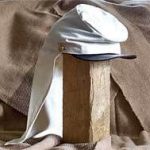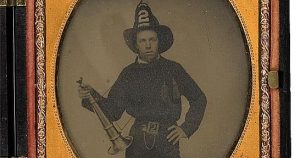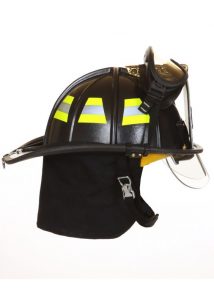Havelocks: The Face Masks of 1861

Ah! Havelocks! A hallmark of the American Civil War in 1861 and then tossed aside, rarely to be seen again—until the 125th re-enactment of the First Battle of Bull Run. After that, rarely.
In case you are wondering, a havelock is a cotton cap covering that keeps the sun off one’s neck. It was made popular with the military by Sir Henry Havelock of the British army in the Sepoy Rebellion in India in 1857. Civil War havelocks fit over the soldier’s cap with its long tail covering the man’s neck. Union kepis were easy to create a havelock for, and northern women sewed and sent havelocks to the federal army in the thousands. Confederate soldiers wore them as well, but since the southern troops wore a variety of headgear, havelocks often fit poorly.

Havelocks were never popular with many of the rank and file. They appeared in 1861 and were rarely seen after that. If the sun was an issue, most Union soldiers preferred to wear a slouch hat, a Hardee hat, or just not worry about getting their neck sunburned. Although havelocks were successfully used in other countries, although loved ones made them, although theories about neck coverings were based on substantial experience and SCIENCE, the camps were soon littered with discarded havelocks. The havelock was supposed to protect men fighting in hot climates from sunstroke. Still, Union and Confederate men complained that wearing a havelock made them hotter by not allowing air to circulate around their heads and necks. Many Civil War soldiers used their havelocks not as cap covers, but as coffee filters, dishcloths, or gun patches. This reaction was similar, I think, to today’s kerfuffle over wearing face masks. Luckily no one was fined or punished for being “havelockless.” It was a matter of choice.

Which brings me to the men of the 11th New York Fire Zouaves. Ever the ones to go against the grain, it was Colonel Elmer Ellsworth’s famous “Pet Lambs” who actually liked wearing havelocks. This topic came up in a discussion a few weeks ago. Fellow ECW historian Sarah Bierle and I spoke on the phone about the cancellation of the ECW Symposium and wishing folks would just wear their masks so we could all get back to meeting together, talking in person, and sharing war stories. I admit it is difficult to speak with me without the topic of Ellsworth coming up somehow, and there we were… talking havelocks. I mentioned that the 11th NY actually loved their havelocks and wrote letters home to ask for more. Private Arthur O’Neil Alcock composed a reasonably regular column concerning the doings of the Fire Zouaves, and on June 20, 1861, from Camp Ellsworth near Alexandria, VA, he wrote:
Just as we expected, our notice in the Atlas, a few weeks since, to the effect that the Regiment was in need of havelocks–and that we knew it would be only necessary to mention the fact to the ladies of New York, in order to ensure a full supply–has been responded to, 1,157 having been this week received from the family of Commodore Smith, U. S. N., Chief of the Bureau of Yards and Docks; 1,000 from Mrs. Fanny Brewer, Misses Fanny Hall and Josephine Lee, of the Fourth District School Washington City. In addition to these, 100 have been sent to Company J, Captain Wildey, from J. C. Mather, and a supply for Company H. Captain Hackett, from Mrs. Rose Roosevelt. All of these donors are entitled to the warm thanks of the Regiment, and may rest assured of our gratitude for supplying us with a most necessary article of comfort.[1]
Additionally, there are several paintings of the Fire Zouaves during the Battle of First Bull Run. I have included two. One shows those “bespangled sons of Mars” defending Griffin’s Battery on Henry House Hill (above); the other shows “Stormin’ Jack” Wildey helping the gallant 69th regain their glorious green flag (below). Both show members of the 11th wearing havelocks.

The question seems obvious: why would Ellsworth’s zou-zous not balk at wearing havelocks when the rest of the Union army tossed them almost immediately? The answer is straightforward–they were firefighters. When the fire bell rang, no matter what time of day or night, the New York firefighters responded immediately. Even in the early 1800s, firefighters dressed for protection, not comfort. The helmets they wore were badges of honor, decked with eagles, lions, bears, or whatever else might represent their own department. Firefighters requested to be buried with their helmets, and most men kept them in good condition.

The shape of a fire helmet is unmistakable, even now. Firefighting headgear has changed technologically to provide fresh air, light, and communication, but its shape has remained remarkably similar to those from well over a century ago. The back of the helmet dips lower than the front, providing neck protection for its wearer. This design is used today, and a secondary havelock is built into the helmet itself.

Did a New York firefighter have a backup havelock? Of course. The second-to-last thing that happened to a volunteer fireman as he left to do his duty to “old New York” was that he ducked his head and a loving wife, mother, or sister placed a wet towel on his head, pulling it down in the back for extra protection. Then the helmet was put on over the towel, kisses were exchanged, and off went the b’hoys (more or less…).

For a firefighter, wearing something to protect the neck was perfectly normal. The men of the 11th wore their havelocks from whenever the box arrived in camp until the day after First Bull Run. After that, unit cohesion was non-existent. Many of the 11th were Confederate prisoners; even more were dead, ill, or wounded. Some were mustered out, others were sent back to New York to recruit men to refill the ranks–which was not a successful endeavor. The Fire Zouaves, the pride of Irish New York firefighters, had been destroyed as a regiment. The havelocks were never worn again in the Union army. But oh! what a grand, if short, history they had been a part of.
REMEMBER ELLSWORTH!
_________________________________________
[1] Brian C. Pohanka, Patrick A. Schroeder, With the 11th New York Fire Zouaves in Camp, Battle, and Prison: The Narrative of Private Artur O’Neil Alcock in the New York Atlas and Leader, (Lynchburg, VA: Schroeder Publications, 2011), 126.
Your comment against mask-wearing detracts from your article.
Thanks for your comment–I thought there were similarities–maybe that was just my interpretation.
The soldiers looked really nice with Havelocks. With wool, heavy backpacks and rifles, Havelocks would have been just something more to deal with, so many chose to not wear them. The horrible East Coast Summer weather, wool clothing and pounds heavy equipment, running up and down, around and through valleys and trees, dodging bullets and cannon fire, sounds terrible. Im glad its over and we can enjoy the battlefield giftshops with air-conditioning, wearing a nice Hawiian shirt.
The “good idea” of the havelock in providing sun protection for neck and face was also found in the Hardee hat. And another early Civil War bit of required kit, the haversack, quickly went the way of the dodo bird. Western soldiers soon recognized what was essential (beyond weapon and ammunition) and rolled it all up in a blanket, tied the ends together, and wore the sling over one shoulder… and found this arrangement could replace the knapsack as well. So the knapsack disappeared, allowing the Western soldier to travel lighter, less encumbered; and yet have all of his essentials with him at all times. [Non-essentials were carried in the regimental wagons.]
As far as the comparison to modern face masks, the question must always be asked: “Is there a better way?”
As a reenactor I’ve worn a havelock when we staged First Bull Run. They are miserable on a hot summer day and like the boys of ’61 I threw mine away. A slouch hat is the way to go.
I sewed a bunch of them for the 125th–good memories!
In addition to what you’ve said, Meg, I would also venture to think that the havelock contributed to their identities as Zouave soldiers, which would be another reason they wouldn’t want to toss them right away. For other Union soldiers whose companies and regiments weren’t defined by their uniform, such an article wouldn’t have seemed necessary once it became cumbersome. But a Zouave would see this accessory as essential to their ensemble and battlefield distinction… Just a thought 🙂
Yep–once a Zouave, always a Zouave!
A Day in September, The Battle of Antietam by Stephen Budiansky has a small section on havelocks. I had seen them in paintings but did not know the name or their history.